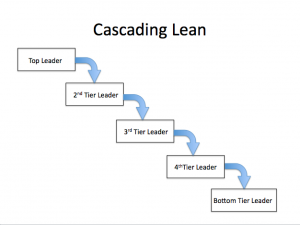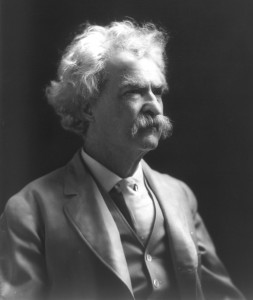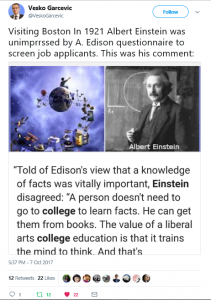In this blog, we sometimes talk about the fact that vital, growing organizations are learning organizations. The lifeblood of a learning organization is knowledge management. For learning to sit at the heart of your organization, leadership needs to recognize and promote knowledge management at all levels. Our guest blogger today is Lean practitioner and author Robert Camp who talks about the qualities of Lean Leadership and how they support a learning organization.
Guest Blogger: Robert Camp
The longer I practice Lean the more I appreciate how great a role good leadership plays in an organization’s transformation.
LEADERSHIP: Honestly, I can think of no other single factor that makes or breaks a transformation so readily.
A LEAN LEADER:
- LEADS FROM THE FRONT
By that I mean they make the time to learn about Lean themselves and make the decision to proceed. No successful transformation can be approached with a “do as I say” attitude. You’re asking people to change, and leading from the front means you have to change first and demonstrate your personal commitment.
- REQUIRES SUBORDINATES TO COMMIT
Lean can’t succeed without a personal commitment from all leaders. That commitment can’t be provisional or halfhearted. Once subordinates have learned what Lean is all about, they need to commit to personally practice and support it. If they can’t or won’t, they’ll need to leave. PERIOD.
- CREATES ENVIRONMENT
You can demand people to change and they will do exactly what’s required, but no more. You’ve won their hands, but not their hearts. Only by creating an environment in which subordinates are led to embrace lean can real change take place. That brings us back to leaders lead by example and coach good performance.
- CASCADES LEAN FROM THE TOP
Most organizations are in a rush to save/make money, so they begin Lean at the bottom of the organization, where money is made. That won’t work.
For Lean to work, employees at each level need to see their leaders demonstrating it first. That means Lean behavior has to cascade down from the top. Anyone who tells you that Lean can work from the bottom up, or the middle out, has never seen a transformation to the end. There’s only one way. Top down!
- EMPHASIZES PHILOSOPHIES OVER TOOLS.
Because the tools save money, everyone’s in a rush to start with the tools first, but tools only support the philosophies. If practitioners don’t understand how Lean works, any gains made with the tools will be short lived.
It doesn’t take years to learn the philosophies. It takes a lifetime, but you can begin your use of a tool as soon as the connection has been made between the tool and the philosophy it supports. Those connections are well covered in “The Toyota Way.”
Lean becomes the WAY you manage, HOW you manage and ultimately, WHY you do everything.
- KNOWS LEAN IS A MANAGEMENT SYSTEM
Lean isn’t something you do in addition to managing your company. It becomes the way you manage. Lean isn’t something you layer on top of everything else you do. It becomes how you do everything. In time Lean becomes why you do everything.
One would think profit or revenue would suffer, but the opposite is true. Lean management leads to a state, a mindset, of continuous improvement; not only reducing the cost of today’s product, but becoming more aware of your customer’s needs and creating products and services to meet or exceed those needs.
- LOOKS TO THE HORIZON
Like all great leaders the Lean leader’s focus is often on the horizon. They are scanning for new ideas, new technologies, new products, etc. Lean leaders don’t spend their time perfecting today, they are constantly on the lookout for things that will enhance their future position in the market.
- HAS PROFOUND RESPECT FOR OTHERS
Fanatical Fans return to do more business and bring others with them. Lean leaders understand that neither money, nor machines, nor technology, nor anything else makes fanatical fans of their customers. They know that only people do that. Whether it’s their suppliers, their employees, or their customers, Lean Leaders recognize the dignity of the people they lead and serve in all they do.
That doesn’t mean Lean leaders are soft. Part of recognizing the dignity of people is to continue to challenge them, to continue to hold them to high expectations. Lean leaders don’t just arbitrarily set new challenges. They collaborate with their suppliers, with their employees, with their customers, always looking to improve. Because the leaders set the standard by embracing change first, others are more open to accepting new challenges and even recommending them.
- CONTINUES TO LEARN AND GROW
Lean leaders don’t end their growth once they’ve embraced Lean. They continue to learn and grow. Moreover, they create an environment in which everyone continues to learn & grow. That is why Lean organizations are frequently referred to as learning organizations.
“Two roads diverged in a wood, and I— I took the one less traveled by, And that has made all the difference.” Robert Frost
If you have recently embarked, or are thinking about embarking, on the road of Lean, ponder these words, as they will have profound impact on your life.
To learn more, visit Getting to Lean or contact Robert Camp at Robert@gettingtolean.com











